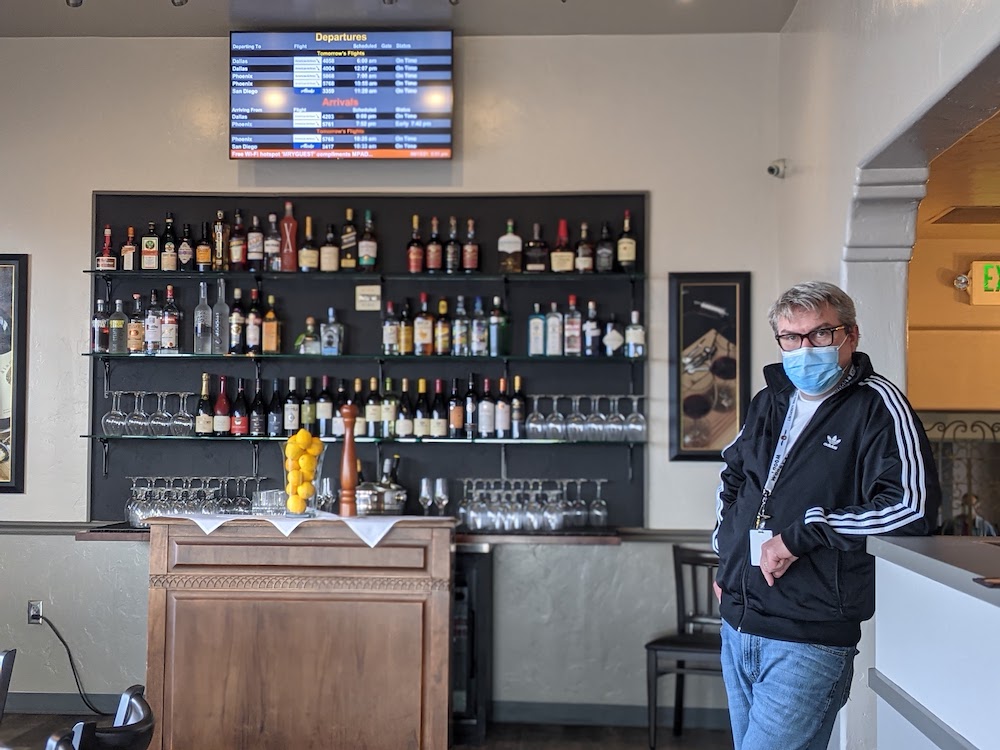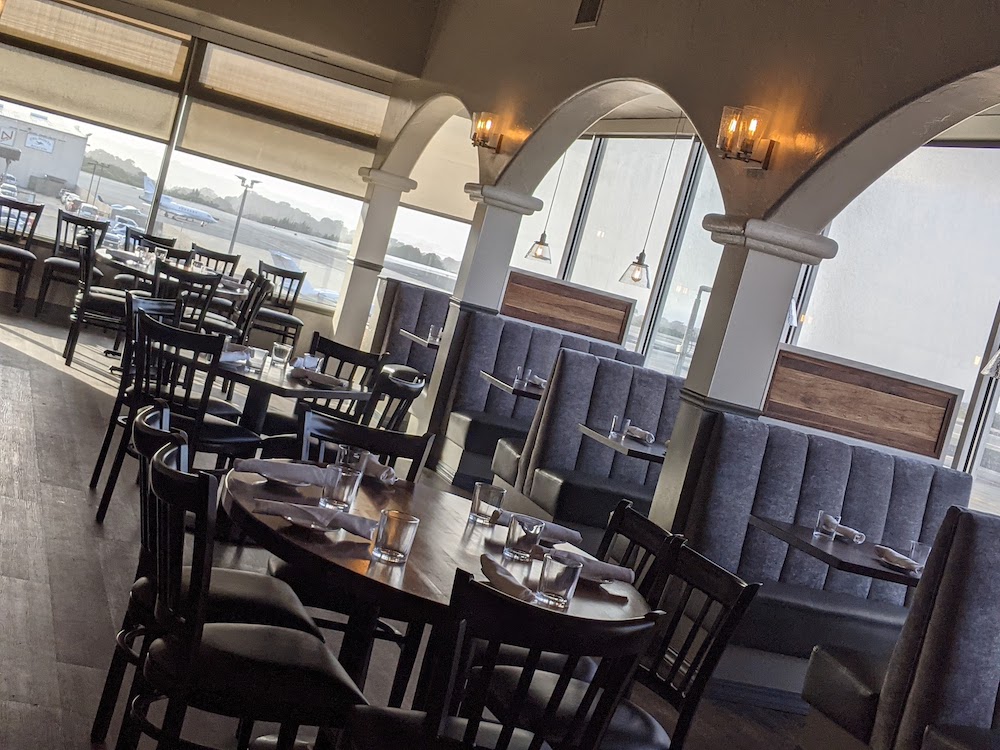April 13, 2021 – Things are looking pretty good in the freshly reimagined dining room of Woody’s at the Airport. Elegant new booths enjoy views of planes launching from the tarmac into the blue beyond. Surreal oceanic paintings now hang on the resurfaced walls. A gleaming bar occupies one side of the long room.

All told, one of the feel-good-taste-good stories of the harrowing COVID era keeps getting better.
Except there’s a problem lurking behind the kitchen door, and at restaurants around the Monterey Bay and across the country: not enough employees.
Woody’s chef-owner and namesake Tim Wood finds himself at the dish pit more and more these days. He’s been looking for a dishwasher for some time, while pitching in on the cleaning that makes the back of the house go.
“You’re talking to the head pearl diver,” he says. “I’m diving for dishes in there.”
He’d also like to hire line cooks, bussers and more servers. Despite using several different recruitment websites and putting the word out through his restaurant network, he’s got more no-shows from interviewees-to-be than anything else.

In his recent piece “As Diners Return, Restaurants Face a New Hurdle: Finding Workers,” the New York Times’ Brett Anderson describes labor shortages from Miami to Manhattan, citing a number of reasons.
They include a big wave of rehiring as restaurants reopen; potential candidates opting for unemployment benefits over long shifts; migrations away from restaurant-heavy urban centers and away from the industry in general; and fear of risks associated from exposure to strangers at restaurants (particularly indoors).
Wood echoes some of that. “If you left when your restaurant closed to go work construction, you’ve been busy as hell,” he says. “You get to work outdoors, and you’re not going to take $10 less an hour to work behind a hot dishwasher.”
I heard the construction theory floated by Melville Tavern owner-operator Ian Penniman too. He told me that on one of four recruitment websites he uses, he can access analytics that reveal 741 people have viewed his listing. He doesn’t need analytics to know zero have applied.
“My glass half-full is this: I don’t have problems, I have challenges,” he says. “But my biggest challenge is hiring.”
He then describes something true of the vast majority of restaurants currently operating, and every single one with whom I spoke for this piece: Longer hours and fewer days off for existing staff, particularly managers, and the risk of burnout that comes with it.
Passionfish co-owner-operator Cindy Walter flags additional factors she’s observed firsthand: Hospitality veterans deciding to take early retirement, and younger restaurant workers—who could barely afford to live here before restaurants closed—leaving permanently.
“The demographic that fills our positions has been greatly reduced,” Walter says.
She runs through other anxieties multiplying the staffing stress—of reestablishing reliable supply chains while everyone scrambles for greater amounts of product, of having to play COVID police with the occasional obstinate customer—but also takes time to highlight pandemic pluses. Chief among them: the advent of their rooftop terrace (with a private room coming) and downstairs patio. “There’s the gold that came out of all this,” she says. “If we can operate there seasonally, it can really be a benefit for our business.”
Like Passionfish and Woody’s, Bernardus Lodge’s Lucia Restaurant—where Wood trained under chef Cal Stamenov—has never looked better. Against the recently updated garden backdrop, Stamenov is introducing an eye-catching “Oceans 21” menu, featuring things like the peekytoe crab tartlet set off with squid ink, electric green pea shoots, and a dollop of sea urchin uni; Monterey red abalone with an onion carbonara and enoki mushroom-seaweed butter; and an Alaskan halibut with a confetti of vegetable crust and carrot-passion fruit emulsion.

It turns out Bernardus is the rare operation that retained a substantial amount of staff, partly due to the fact that its lodging supported essential workers responding to pandemic surges at Community Hospital for Monterey Peninsula. But even with a loyal base team, Bernardus has made a point to increase wages and is still navigating both an uptick in turnover and greater workloads all around.
“Like many, we’re paying more and we’re trying to do our best to keep people,” says the chef. “We still have to maintain a level of service and food, so we’re doing fewer things better.”
Stamenov, the area’s chef emeritus, has seen a lot across decades of close industry attention. But nothing like the hiring spike now happening locally, citing the massive recruitment push underway at Pebble Beach Company and restaurants across the country.
“I’ve never seen two- and three-star restaurants put out Instagrams saying, ‘We are hiring,’” he says. “It’s never been the case.”
Like Lucia and Pebble Beach restaurants, Passionfish is one of the better restaurants, and food-service work environments, in the area. Wood is similarly famous for his work ethic, and for advocating on behalf of his workers, particularly back-of-the-house staff. His place will likely become like Bernardus and Passionfish, the type of places where servers stick around for decades, as the number of early-retirement-eligible Passionfish staff indicates.
Which begs two questions: 1) If these places are experiencing labor shortages, what’s happening at less conscious kitchens? And 2) Is the classic restaurant model fundamentally doomed and/or outdated—in a way the pandemic made clear for those providing its life force?
Today, restaurant critic Tejal Rao spoke to the latter with a New York Times essay titled: “What Is Hospitality? The Current Answer Doesn’t Work.” With reporting and nuance, the essay paints a textured portrait of what’s ailing the industry, namely an imbalance brought into sharp—and even violent—relief through this worker drought and events like customers at a Houston-area Mexican restaurant threatening staff with deportation after the staff wore masks.
“This incident points to the profound dysfunction at the heart of the American hospitality industry, which routinely devalues the labor that runs it, and often diminishes the people who make restaurants worth going to in the first place,” Rao writes. “Before hospitality was a business, it was more of a virtue—a barometer of civilization. And in light of the past year, and the extreme hospitality expected from workers during a global pandemic, it might be helpful to think of it that way again.”
As part of a writing residency through which I lived and worked at Orcas Hotel & Cafe last summer, I spent a lot of time in the kitchen watching a small, tight knit team operate. To a person, that team, which also ran the front of the house in a community-driven model of sorts, had that barometric virtue.
The kitchen often produced spellbinding specials—like a seared abalone dish that looked like a sculpture and tasted like butter, but better. But the most amazing meal I watched happen was defined by something far more abstract than abalone: A couple on a super late ferry begged for something, anything, to eat from the kitchen.
I was talking with chef Quinn Thompson in the funky and historic cafe. I suggested he assemble a nice spread of charcuterie that was ready in the cooler, maybe with some of the incredible house chocolate chip cookies. Even though he’d been clocked out for 90 minutes, he asked what they might like from the menu and made them glorious cooked-to-order bacon cheeseburgers and fries delivered to their room.
I am telling you this for few reasons.
One, Thompson is a hospitality lifer like Wood, Penniman, Walter and Stamenov, and the many workers I know on their teams, from Rose the timeless bartender (at Woody’s) to Gennica the anti-racist yogini-super server (at Lucia).
They would all likely be doing this if it paid them next to nothing and cost them mental and physical health, which, it turns out, is often the case.
“In a word, my strategy among all the pandemic challenges and pivots is, ‘Embrace,’” Penniman says. “I wouldn’t do it if I didn’t have fun.”
Two, because we can take advantage of someone’s generosity doesn’t mean we should.
Three, the guests at Orcas were over the moon grateful, and expressed it with gratitude that was direct and indirect. Thompson’s boss was similarly grateful. It’s no coincidence that the boss, Edible contributor John Cox, asks his team to take big chunks of time off to avoid burnout.
Four, I was grateful too. What he did inspired me to wash the plates that night, as my own offering of respect.
After all, I had started doing so to help get us through the high season’s busiest nights, and it taught me about some of the things I take for granted, as has this labor shortage.
Maybe I can pick up a shift at Woody’s.
About the author
Mark C. Anderson, EMB's managing editor and "Found Treasures" columnist, welcomes responsible and irresponsible feedback. Correspond via mark@ediblemontereybay.com.
- Mark C. Andersonhttps://www.ediblemontereybay.com/author/markcanderson/
- Mark C. Andersonhttps://www.ediblemontereybay.com/author/markcanderson/
- Mark C. Andersonhttps://www.ediblemontereybay.com/author/markcanderson/
- Mark C. Andersonhttps://www.ediblemontereybay.com/author/markcanderson/



